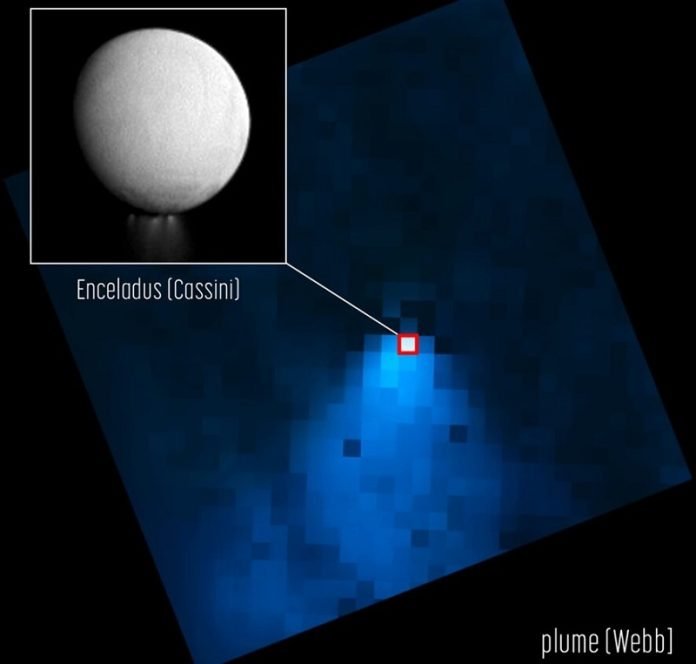
Scientists have made an astonishing discovery about one of Saturn’s moons, Enceladus, using the powerful James Webb Space Telescope (JWST).
The telescope captured images of a colossal plume of water vapor erupting from the surface of Enceladus, stretching over 6,000 miles—roughly the distance from the United States to Japan.
This finding has sparked excitement among researchers who are eager to explore the potential habitability of this intriguing ocean world.
Enceladus has been a subject of interest since NASA’s Cassini spacecraft explored the Saturn system for over a decade.
Cassini’s observations revealed the presence of a subsurface ocean beneath Enceladus’ icy exterior. The spacecraft analyzed samples of ice grains and water vapor that spewed into space from cracks in the moon’s surface.
The recent observations made by the JWST’s Near InfraRed Spectrograph have yielded even more remarkable results. The data unveiled a story about Enceladus that was previously unknown.
As the moon swiftly orbits Saturn in just 33 hours, it expels water, leaving behind a halo-like trail. The plume is not only enormous but also extends to Saturn’s dense E-ring.
Surprisingly, JWST data indicate that roughly 30 percent of the water remains in Enceladus’ wake, while the remaining 70 percent escapes to supply water to the rest of the Saturnian system.
Dr. Christopher Glein from the Southwest Research Institute (SwRI), a prominent expert in extraterrestrial oceanography, is leading the research team studying Enceladus.
Thanks to the JWST’s incredible sensitivity, they can delve deeper into understanding the plume and the key chemical compounds present on the moon’s surface, shedding light on its potential habitability.
The initial data from JWST left the scientists astounded. Geronimo Villanueva from NASA’s Goddard Space Flight Center, the lead author of the recent paper, described his initial reaction as “shocking” upon discovering a plume over 20 times the diameter of Enceladus.
The plume extends much farther than anyone could have imagined.
Dr. Silvia Protopapa, another team member from SwRI and an expert in the composition of icy bodies in the solar system, highlighted how the JWST observations visually depict the role of Enceladus’ water vapor plumes in the formation of a torus, which is a donut-shaped structure around the moon.
This demonstrates the extraordinary capabilities of the JWST and excites the team as they continue their search for signs of habitability and plume activity on Enceladus.
Motivated by these extraordinary findings, Dr. Glein and his team will conduct additional observations of Enceladus using the JWST in the coming year.
They will specifically search for indicators of habitability, such as organic signatures and hydrogen peroxide, which could provide potent sources of metabolic energy.
The results will help scientists determine if samples from Enceladus’ ocean are widely distributed over its surface or restricted to the vicinity of the south pole.
The JWST observations also play a crucial role in planning future missions to Enceladus. By understanding the time variability of plume outgassing, scientists can prepare for upcoming planetary science missions that aim to explore these fascinating water plumes.
Dr. Glein anticipates that the JWST can act as a bridge between the Cassini mission and a proposed mission called Orbilander, which will focus on searching for life.
The upcoming observations with JWST will provide valuable insights into whether ocean samples can be accessed near the equator of Enceladus, which could expedite our return to this intriguing moon.
This groundbreaking research was recently accepted for publication in Nature Astronomy, a prestigious scientific journal.
High school students now have the opportunity to learn about these exciting discoveries, paving the way for future explorations and the ongoing search for extraterrestrial life.



